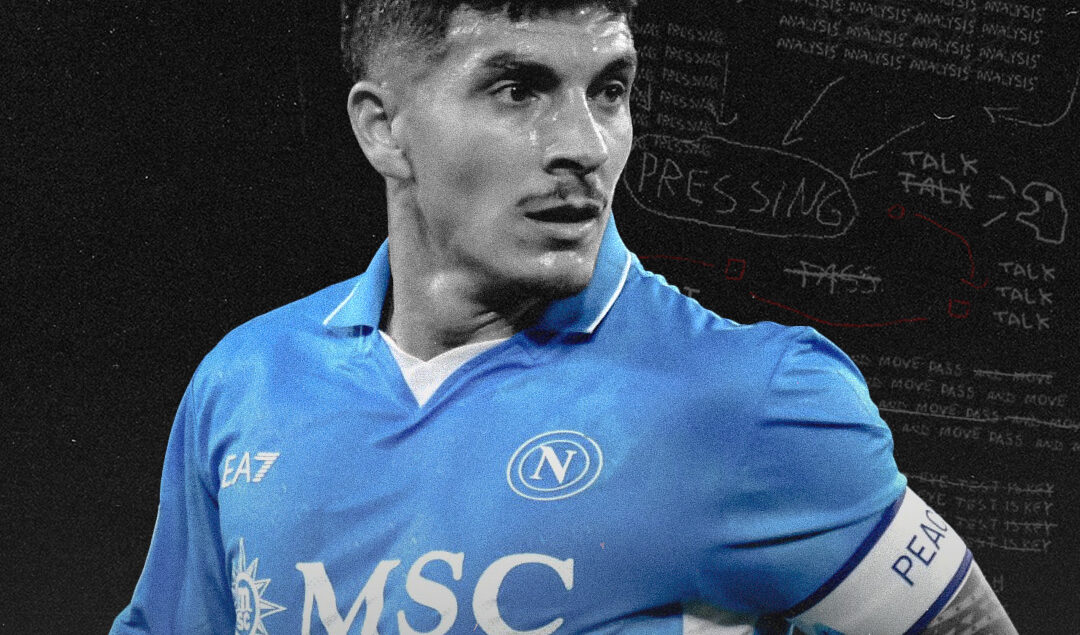Antonio Conte’s Napoli: Reinventing a Club and Himself
Antonio Conte is a manager who needs little to no introduction. He’s won multiple league titles with different teams on multiple occasions. His only trophy-less job in recent times came at Spurs, but even then, he’s still the only manager who guided Tottenham Hotspur to a top-four Premier League finish since Mauricio Pochettino was sacked.
The man is a serial winner and one of the best managers of the modern era. At the beginning of this season, he was putting his reputation on the line by taking the Napoli job after a tough spell at Tottenham and a year-long hiatus following a fallout with both the board and the fans.
Giovanni Di Lorenzo: Napoli’s Captain Enjoying a Fresh Start Under Conte
High Stakes in Naples
A failure in Naples could’ve led people to believe Antonio Conte had lost his touch. With all the drama surrounding the club when he took over, most people were expecting a top-four finish at best.
Napoli were three-time Scudetto winners at the beginning of the season — two during Diego Maradona’s era (which led to the stadium being named after him) and the third under the Victor Osimhen – Khvicha Kvaratskhelia duo managed by Luciano Spalletti.
After Spalletti’s resignation in June 2023, Napoli had a disastrous title defense in the 2023/24 season, cycling through three managers and falling from 1st to 10th place. They finished 41 points behind Inter Milan and only 18 points above the relegation zone.
Andre-Frank Zambo Anguissa: Napoli’s Combative Midfield General
To put it in perspective, Napoli as reigning champions were more than twice as far in points from 1st place as they were from relegation. The gap between 10th-place Napoli and Inter (41 points) was even greater than that between Napoli and bottom-placed Salernitana (36 points). If there was anyone capable of salvaging that, it was Antonio Conte.
Conte’s Tactical Blueprint
As many know, Antonio Conte is a back-three manager. Although this system isn’t common in modern football, it still delivers results, as seen with Thomas Tuchel at Chelsea, Rúben Amorim at Sporting CP, Simone Inzaghi at Inter, and Xabi Alonso at Leverkusen.
In fact, it’s fair to say Conte laid the foundation at Inter Milan for Inzaghi’s success after his own Scudetto win ended Juventus’ dominance. His system relies heavily on athletic wingbacks who cover the pitch for 90 minutes—key to both attack and defense.
In the defensive phase, Conte’s teams shape into a 3-5-2 or 3-4-2-1, with wingbacks dropping deep to form a back five, three players patrolling midfield, and two forwards pressing high or ready to counter. This structure allows for quick transitions and defensive stability.
When in possession, Conte’s wingbacks push high and combine with midfielders and forwards to create wide overloads, aiming to deliver crosses. If the opposition shuts down one flank, Conte instructs a quick switch to the opposite wingback, who is expected to attack while the defense is still adjusting.
Adapting at Napoli
Conte’s system brought titles to Juventus, Chelsea, and Inter. But at Napoli, after a heavy 3–0 loss in his debut and likely learning from his Tottenham stint (where Emerson Royal and Sergio Reguilón weren’t ideal wingbacks), Conte reassessed. He shifted from a back three to a back four—on paper a small change, but tactically a major one.
How Napoli’s Rock-Solid Defense Paved the Way to Serie A Glory
This change allowed for central overloads instead of relying on wide play, which suited players like Romelu Lukaku and Scott McTominay better. Napoli began building up in a 2-4-2-2 shape, looking to play vertically with Lukaku and McTominay as target outlets. Wingers operated more centrally, with fullbacks ready to play inside or wide depending on the situation.
When advancing into the opposition half, Napoli morphed into a 4-2-2-2 with wingers drifting inside to create a central corridor. Fullbacks provided width, while midfielders rotated to support the backline and keep defensive shape intact.
A New-Look Attack
This structure a 3-1-4-2 gave Napoli five central attackers, overwhelming defenses. McTominay, in particular, thrived—scoring 12 goals and adding 2 assists, earning the Serie A Player of the Year award. Lukaku became the league’s top assist provider. McTominay’s fluidity, constantly shifting between midfield and attack, confused defenders and created space. His movement pulled defenders out of position, opening gaps for wingers or fullbacks to exploit.
Scudetto Scassat’: How Napoli’s Nightmare Season Unfolded after Spalletti’s Scudetto Success
Conte’s Napoli also evolved from a cross-heavy team to one relying more on cutbacks and through balls. Lukaku, while positioned centrally, wasn’t tasked primarily with scoring. Instead, he held up play and fed others, a shift from Conte’s previous systems.
Defense Still Wins Titles
While Conte evolved offensively, defensively he remained true to form. Napoli defended in a 5-3-2, with winger Politano dropping into the back five and McTominay joining Zambo Anguissa and Stanislav Lobotka in midfield. Lukaku and David Neres (or Kvaratskhelia earlier) remained up top.
The team didn’t press high. Instead, they dropped quickly into a compact shape, forcing play wide and cutting off central buildup. With two players up top, they always had an outlet to trigger a counterattack.
A Resurgent Napoli
This is how Antonio Conte not only reinvented Napoli—guiding them to their fourth Scudetto and second in three years—but also evolved his own tactics. He turned Napoli into one of Europe’s most exciting teams this season.
With the likely sale of Osimhen and the mid-season departure of Kvaratskhelia to PSG, Conte will likely have the resources to reinforce the squad for a deeper Champions League run and another Serie A title defense. The foundations are strong, and if momentum holds, more silverware could follow.
By: Sekwila Mumba / Instagram: https://www.instagram.com/s3kwila
Featured Image: @GabFoligno / Image Photo Agency / Getty Images
